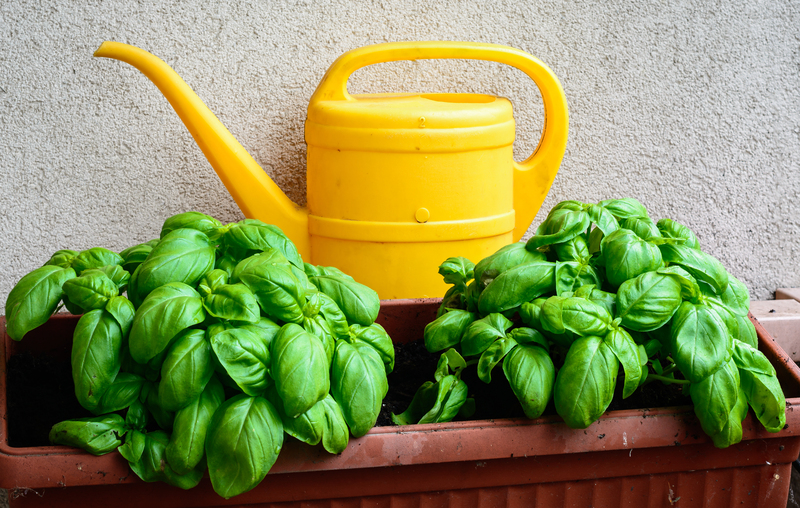Create Stunning Gardens with Hedge Trimming Shapes
Posted on 13/06/2025
Create Stunning Gardens with Hedge Trimming Shapes
Have you ever strolled through a garden and found yourself mesmerized by the captivating shapes and meticulous lines of trimmed hedges? Hedge trimming shapes can elevate any landscape from ordinary to extraordinary, whether you have a sprawling estate or a cozy backyard. In this comprehensive guide, we'll show you how to create stunning gardens using hedge trimming techniques, the best types of plants to use, trending shapes, and step-by-step advice for beginners and seasoned gardeners alike. If you're ready to transform your outdoor space, keep reading to discover the secrets of beautifully sculpted hedge designs.

Why Hedge Trimming Shapes Enhance Your Garden
Carefully sculpted hedges do more than just define spaces--they act as living art, adding personality and structure to your garden. Garden design with hedge trimming shapes can:
- Improve curb appeal and instantly increase property value
- Create privacy and shield your garden from prying eyes
- Add visual interest and texture--from winding spirals to crisp geometric patterns
- Encourage healthy plant growth by promoting air circulation and sunlight exposure
- Channel your creativity by experimenting with different forms and topiary art
By incorporating a variety of hedge trimming styles, you can transform your garden into an inspiring and tranquil retreat, all while making a bold landscaping statement.
Popular Hedge Trimming Shapes and Styles
The options for hedge shaping are virtually limitless! Let's explore some of the most popular and eye-catching trimming styles to consider for your garden:
1. Geometric Shapes
- Box Shapes: Simple, clean, and classic--perfect for borders and pathways.
- Spheres and Globes: Lend an elegant, modern touch and work well in both formal and informal gardens.
- Pyramids and Cones: Add architectural interest and vertical emphasis to garden beds.
2. Topiary Art and Animal Shapes
- Animal Forms: Turn shrubs into whimsical creatures--think peacocks, rabbits, or elephants.
- Abstract Sculptures: Express creativity with spirals, spiraling columns, or fantastical shapes.
3. Natural and Soft Contours
- Cloud Pruning: Mimics the look of fluffy clouds, blending traditional shaping with a modern twist.
- Waves and Curves: Add a dynamic, flowing movement throughout your landscape.
Experiment with mixing multiple shapes to create dynamic garden rooms or to direct the eye towards focal points like water features or statues.
Best Plants for Hedge Trimming Shapes
The success of your hedge trimming project depends on choosing the right plants. Here are the best options for shapely and healthy hedges:
1. Boxwood (Buxus)
Boxwood is the gold standard for topiary and sculpted hedges. Its dense, small leaves tolerate frequent trimming and grow uniformly.
2. Yew (Taxus)
Another classic, Yew is ideal for intricate shapes, especially cones and animals, due to its fine foliage and remarkable ability to regrow even after heavy cuts.
3. Privet (Ligustrum)
Fast-growing and resilient, privet is great for beginners and is often used for privacy screens and geometric patterns.
4. Holly (Ilex)
Holly not only provides a lush backdrop for shaping but also bears attractive berries for added seasonal appeal.
5. Viburnum, Laurel and Euonymus
- Viburnum: Tolerates clipping and has lush foliage.
- Laurel: Perfect for larger, bold shapes.
- Euonymus: Offers colorful leaves and withstands repeated pruning.
Whichever you choose, pick healthy young plants for best shaping results, and position them in well-drained, fertile soil.
Essential Tips for Crafting Unique Hedge Trimming Shapes
Planning is as important as execution when it comes to hedge design. Follow these expert tips for creating your own leafy sculptures:
1. Outline Your Design
- Sketch your garden and mark where you want different shapes and sizes.
- Use string, stakes, or wire frames as guides to help maintain consistent lines while trimming.
2. Start Small and Shape Gradually
- Don't try to create complex forms from the get-go. Begin with simple shapes and refine them over time.
- Gradual training encourages healthy growth and reduces the risk of damaging your plants.
3. Use the Right Tools
- Manual hedge shears are best for precision work; electric or battery-powered trimmers are suited for longer, straight edges.
- Invest in quality, sharp tools and disinfect them after use to prevent disease spread.
4. Time Your Trimming
- For most evergreen hedges, late spring and late summer are ideal for shaping.
- Deciduous plants may only require one trim, after their growth spurt in mid-summer.
5. Prune for Health
- Focus on removing dead or diseased wood before detailed shaping.
- Open up the hedge slightly at the base to ensure light penetration and avoid bare spots.
Step-by-Step Guide to Shaping a Box Hedge
Let's walk through the process of creating geometric hedge shapes, using a classic box hedge as our example:
- Mark your boundaries with string and stakes for a straight line.
- Trim the sides first, using the line as a guide and holding your shears parallel and steady.
- Shape the top flat, working from one end to the other for consistency.
- Repeat throughout the season as new growth appears to maintain crisp edges.
- Step back frequently to assess your progress and adjust for symmetry.
For advanced shapes, like spheres or cones, consider using frames or templates, and always remember to step back and view the hedge from multiple angles as you work.
Creative Trends in Hedge Shaping and Garden Design
The art of hedge trimming shapes is constantly evolving! Here are some creative trends making waves in the world of garden aesthetics:
- Mixed Geometry: Combine cubes, cones, and domes for a contemporary, layered look.
- Curtain-Style Hedges: Hedges cut with undulating, curtain-like curves create whimsical transitions in garden paths.
- Themed Gardens: Trim hedges into letters, symbols, or animals to express a family's personality or historical theme.
- Cloud Pruning: A minimalist style inspired by Japanese gardens, with layered mounds resembling drifting clouds.
Inspirational Examples from Award-Winning Gardens
Award-winning landscape designers often use hedge trimming artistry to wow guests. For example:
- The Gardens of Versailles are renowned for their elaborate geometric parterres and intricate hedge patterns.
- Topiary mazes and animal-shaped hedges are a highlight at Levens Hall in England.
- Modern city gardens increasingly feature minimalist hedges, pruned into blocky, architectural shapes for privacy and style.
Drawing inspiration from these examples can help you find a distinct style that suits your personality and space.
Common Mistakes to Avoid with Hedge Trimming
While shaping hedges can be an enjoyable and rewarding process, watch out for these common mistakes:
- Trimming at the wrong time: Pruning during the wrong season can lead to uneven growth or harm flowering hedges.
- Cutting too far into old wood: Many shrubs do not regrow well from old, bare stems.
- Neglecting symmetry: Always check from different angles and distances for balance and proportion.
- Letting tools get dull: Dull shears cause ragged cuts, stress plants, and invite disease.
- Ignoring plant health: Address pests, watering, and soil quality as part of your hedge care routine.
Eco-Friendly and Sustainable Hedge Shaping
Eco-conscious gardeners are increasingly interested in using native shrubs for hedging, which support local wildlife and pollinators. Complement your garden's hedge designs with:
- Flowering shrubs for bees and butterflies
- Berry-producing hedges for birds
- Mulching to reduce water needs and suppress weeds
- Organic trimmings for composting
Consider incorporating gaps or passageways in dense hedges to help small mammals and amphibians navigate your garden.

Maintenance Checklist for Lasting Beauty
To ensure your garden hedge shapes remain beautiful year after year, follow this simple checklist:
- Trim regularly during the growing season for crisp lines.
- Inspect for pests or disease after each trim.
- Water young hedges until well established.
- Fertilize in spring with balanced, slow-release nutrients.
- Sharpen and clean tools after every use.
Conclusion: Transform Your Space with Artistic Hedge Trimming
The world of hedge trimming shapes offers something for every gardener, from formal parterres to creative, free-form topiary art. By investing time in proper plant selection, planning, and maintenance, you'll enjoy a garden that delights the senses and reflects your unique vision.
Whether you love the crisp edges of geometric lines or the playful charm of animal forms, hedge sculpting is both a practical and artistic pursuit. Start small, be patient, and let your creativity flourish. Before long, you'll have a stunning garden landscape that is sure to impress friends, family, and passersby.
If you're ready to turn your garden into a living masterpiece, grab your shears and start shaping--your dream landscape awaits!

